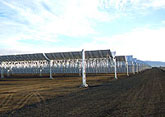Entergy Nuclear and the state of New York have agreed to retire the two nuclear reactors of the Indian Point Energy Center, 25 miles north of New York City. They will cease their activity in a staggered way, one in April 2020 and the other one, one year later.
The closure dates announced could be postponed four years based on a mutual agreement between Entergy and the New York State Government if the reliability of electricity in the region is significantly impacted or if other emergency circumstances arise, the EIA reports.
Four nuclear power plants in New York
Indian Point is one of four nuclear power plants located in the State of New York and accounts for about 12% of the total electricity generated in it. Entergy wanted to renew the generation license, however, the State of New York was concerned about the environmental and safety challenge of its operation due to its proximity to New York City center.
Two reactors operate at Indian Point, each with an authorized capacity of 1,072 megawatts (MW). These two units began their commercial operation in 1974 and 1976. A third, smaller, was opened in 1962 and was closed in 1974 because the core emergency cooling system did not meet regulatory requirements. With a total capacity of 2,144 MW, Indian Point represents 40% of the state’s nuclear capacity and 5% of the total installed capacity of its electricity generation.
Source: EIA
Although Indian Point accounts for 5% of New York’s power generation capacity, the plant provides about 12% of the state’s total electricity generation. The EIA explains that nuclear power plants tend to operate as base load generators, providing more electricity throughout the day compared to other plants that are more likely to operate during hours of high electricity demand or, in the case of some renewable generators, when their resources are available.
Based on the latest annual data from the United States, a nuclear power plant in operation typically has a capacity factor of some 90% versus 55% for natural gas combined cycle plants or 30% – 35% for wind power, for example.
New York State Electric Mix
Natural gas generation accounted for 41% of New York’s electricity generation in 2015. In recent years, natural gas combined cycle plants have become more competitive as base-load electricity generators. Relatively low natural gas prices and new infrastructure projects have increased the amount of natural gas that can be derived to production areas in Ohio or Pennsylvania.
The Clean Energy Standard state plan aims to add more capacity and generation from “nonhydro” sources such as wind and photovoltaic. Specifically, they want them to represent 50% of the state’s generation by 2030.
Carlos Sánchez Criado
Publicista por la Universidad Complutense. Director comercial de publicaciones técnicas del sector de la energía durante doce años. Director de Energy News Events, S.L. desde 2012 difundiendo información en Energynews.es, movilidadelectrica.com e hidrogeno-verde.es. Y por supuesto, organizando eventos como VEM, la Feria del Vehículo Eléctrico de Madrid.


























